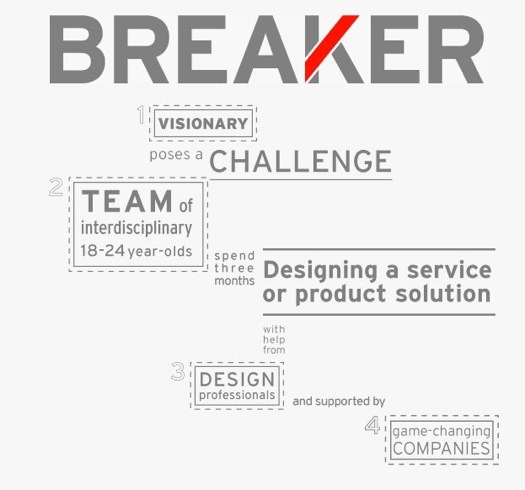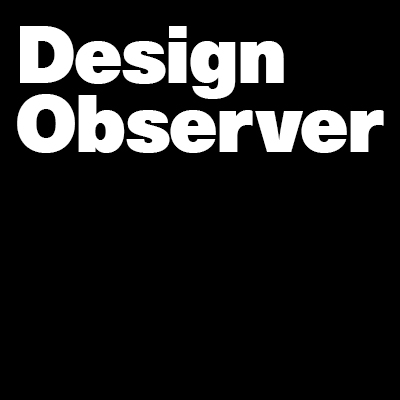
Breaker process, as visualized on website
Juliette LaMontagne, Ed.D., is a career educator: New York City public school teacher, Columbia University professor and professional developer. She’s a TED Senior Fellow and innovation consultant for the Asia Society’s International Studies School Network, the Center for the Professional Education of Teachers and the Student Press Initiative. Her new project, which she recently discussed with Change Observer, is Breaker.
Tell us about the pilot program you ran this summer. What is Breaker?
Breaker’s goal is to drive alternative learning and social innovation by mobilizing interdisciplinary teams of young creative collaborators to help solve some of the world’s most pressing problems. We connect our teams of 18- to 24-year-olds with global thought leaders and industry experts to answer major challenges like, in the case of our summer pilot, the future of the book and its impact on literacy. We facilitate a creative problem-solving design process and teach the entrepreneurial skills necessary to transform ideas into businesses.
Each unique Breaker project is a 12-week collaboration between the Breaker team, the visionaries who pose their challenge, and the industry experts who support their process. We work with multiple partner organizations across New York City to ideate, build and test real solutions with real market value.
In the Future of the Book project, our techno-bibliophilic visionaries, Charlie Melcher of Melcher Media and Tom Uglow of Google Creative Labs, inspired the team to imagine the future of the book. We then tasked them with designing a product or service that would get kids reading — and keep kids reading — during those pivotal middle school years when 12- to 14-year-olds either adopt reading as an independent practice or read only to get by. From the outset, the team was primed to make their concepts marketable.
How did you choose the team?
We assembled a group with diverse domains of intelligence, and not because they had any particular expertise around adolescent literacy. Nor were these designers or entrepreneurs – not yet, anyway. In fact, I know some of them doubted at first just how their skills might have relevance to the goals of the project. We look for passion and curiosity, and diversity in thought, rather than specific skills or backgrounds. For the pilot, we reached out to DoSomething, Bezos Scholars, 826 Valencia, Teach For America’s Lead Now Initiative, and the Asia Society’s ISSN. Our intention is to expand our outreach and tap the growing lot of young people seeking hands-on learning experiences with potential for social impact.
What happened during your 12 weeks together?
The team began exploring the what, where, when, why and how adolescents engage with texts of all kinds. They researched the middle school demographic inside and outside of schools in New York City and beyond, interviewed kids, literacy experts, librarians, teachers and parents, and read the relevant studies. At IDEO, they began to unpack the data and learn about the human-centered approach to design. Each subsequent stage of the process from ideation to prototype was informed by experiences with co-location partners at MTV Scratch, Fuseproject, Google, and AOL Ventures Q Labs, as well as numerous advisors and facilitators who visited Breaker’s base camp at the Metropolitan Exchange maker space in Brooklyn. They learned to refrain from solutions too early on; to study the market and develop metrics; to embrace failure as a way to learn; to build narratives around their product and user; to communicate their concepts in clear and concise ways. In the end, the team whittled their concepts down to two and pitched them to the edTech accelerator Startl.
What resulted from the pilot?
We see participants leaving Breaker with new perspectives and abilities, and with products ready to be stress-tested and developed. So, although the Future of the Book project came to a formal close in August, some of the team, by their own volition, continue to push forward with the products independently. They are MoBo: a service for receiving, sharing and engaging with stories via text message, and Unbound: an online user-generated video resource. Both are in development, testing prototypes, and seeking seed funding.
There are legions of underestimated young people with new insights into old problems who need only to be asked, in specific ways, for their contributions. And when those individuals see the impact of their creative capital on the marketplace, you have a new breed of social entrepreneur changing the world.
What’s next for Breaker?
Future of the Book is the first in a series of unique three-month projects led by different global visionaries and supported by various industry experts. Each new project will coalesce a different set of collaborators and a new team. We’re building the next project around Urban Micro Agriculture, led by visionary Majora Carter. This team is tasked with creating a product or service that envisions a new role for urban micro agriculture within a broader ecosystem of food and agricultural consumption, one that turns urban gardening into enterprising agriculture.
You call Breaker an alternative learning model. What do you mean by that?
A couple of things: many young people are dissatisfied with educational experiences that fail to connect content learned with the skills needed for today’s economy. They’re looking for opportunities to contribute to meaningful work with real-world relevance. In light of uncertain job prospects and growing student loan debt, some seek opportunities to supplement their college course work, others to supplant it. I’m excited to see the growing number of alternative learning pathways available to students who have not been well-served by traditional schooling – and to contribute Breaker to the available options.
Online learning presents some effective alternatives and has certainly changed our notions of how and where people are schooled, but young people still need to experience the messy, nuanced negotiations of collaborative work in face-to-face contexts. Similarly, online networks are important, but face-to-face touch points are often what flip the switch on collaborative efforts. Real-life networks and mentors (beyond teachers) are vitally important to future job prospects. Through Breaker, we’re able to connect a younger generation to an established network of thinkers and doers for the kind of high-touch collaborations that complement the virtual world.
How does your classroom teaching experience inform the Breaker model?
When you work with students who aren’t motivated by grades, you find other ways to incentivize them. In my experience, if you challenge students with real-world deliverables, support them by scaffolding instruction at every step, require accountability, and maintain unwavering faith, they will deliver. While they may not contribute in equal shares, they will contribute in equitable shares that capitalize on their strengths; the whole of creative collaboration is greater than the sum of its parts – this is what a culture of high-stakes testing misses.
How has design influenced the model?
It wasn’t until I began attending TED in 2009, as a Fellow, that I began to rethink my long history with project-based learning in terms of design thinking and social enterprise. I found that user-centered design required the same rigorous research, interviewing and empathy work that was the central to the projects I taught; I appreciated the permission to fail inherent in an iterative methodology; I was attracted to the idea of designing solutions within the constraints of the marketplace. In short, I began to see problems and their solutions not only as academic exercises but as opportunities for product and service development. And I saw the educative and entrepreneurial potential for students.
Are there similar models you look to?
Breaker falls between two camps: organizations committed to incubating young leaders by providing holistic empowerment training: helping to identify passions, building communities, developing skills; and venture incubators dedicated to fostering nascent products and the young talent behind them. Obviously the two are not mutually exclusive, but Breaker proposes a space between where young, creative collaborators are tasked with solving challenges in a learning experience that culminates in a social enterprise. The fact that our participants would rarely self-identify as designers or entrepreneurs is an asset; fresh solutions to entrenched problems demand precisely the kind of insights that come from a degree of naïveté.
To learn more about Breaker, visit our website.

